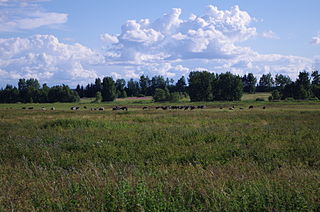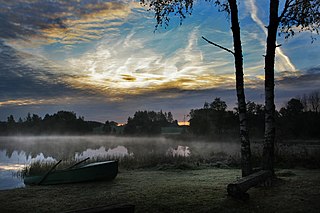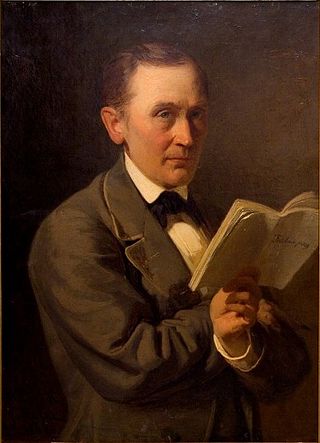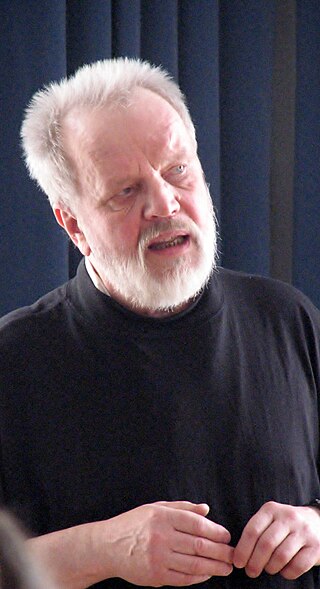
Tartu is the second largest city in Estonia after Tallinn. Tartu has a population of 97,435. It is 186 kilometres southeast of Tallinn and 245 kilometres northeast of Riga, Latvia. Tartu lies on the Emajõgi river, which connects the two largest lakes in Estonia, Lake Võrtsjärv and Lake Peipus. From the 13th century until the end of the 19th century, Tartu was known in most of the world by variants of its historical name Dorpat.

The Singing Revolution was a series of events from 1987 to 1991 that led to the restoration of independence of the three Soviet-occupied Baltic countries of Estonia, Latvia, and Lithuania at the end of the Cold War. The term was coined by an Estonian activist and artist, Heinz Valk, in an article published a week after the 10–11 June 1988 spontaneous mass evening singing demonstrations at the Tallinn Song Festival Grounds.
A student society, student association, university society, student club, university club, or student organization is a society or an organization, operated by students at a university, college, or other educational institution, whose membership typically consists only of students and/or alumni.

Tartu County is one of 15 counties of Estonia.

Võru County is a county in southern Estonia. It is bordered by Valga and Põlva counties, Latvia's Alūksne and Ape municipalities, and Russia's Pskov Oblast.

Lydia Emilie Florentine Jannsen, known by her pen name Koidula, was an Estonian poet. Her sobriquet means '(Lydia of) The Dawn' in Estonian. It was given to her by the writer Carl Robert Jakobson. She is also frequently referred to as Koidulaulik – 'Singer of the Dawn'.

Kannel is an Estonian plucked string instrument (chordophone) belonging to the Baltic box zither family known as the Baltic psaltery along with Finnish kantele, Latvian kokles, Lithuanian kanklės, and Russian gusli. The Estonian kannel has a variety of traditional tunings. In Estonia, studying the kannel has made a resurgence after some years of decline.

Vanemuine is a theatre in Tartu, Estonia. It is the first Estonian-language theatre. Stemming from the Vanemuine Society (1865), the theatre's first performance was Lydia Koidula's Saaremaa Onupoeg at the society's fifth anniversary. In subsequent years, Vanemuine has expanded to include a symphony orchestra and ballet company, while its repertoire has included a range of operettas and music theatre through operas and dramas. Under Karl Menning, the theatre served a vocational purpose, with a great emphasis on educating future talent. Subsequent directors prioritized entertainment value, while Kaarel Ird—who led Vanemuine for more than forty years—oversaw a blend of genres as well as tours of the Soviet Union. In recent years, content has varied extensively.

The history of Jews in Estonia starts with reports of the presence of individual Jews in what is now Estonia from as early as the 14th century.
Vanemuine (Eldermost) is a god of music in the artificial Estonian mythology created by Friedrich Robert Faehlmann and Friedrich Reinhold Kreutzwald. His name is probably derived from the Finnish Väinämöinen. Vanemuine is mentioned in the opening strophe of the epic Kalevipoeg by Kreutzwald.
The Estonian Institute is a non-governmental and non-profit organisation based in Tallinn aiming to promote Estonian culture abroad. The institute was founded in 1988/1989 as a shadow foreign office for the Estonian independence movement by Lennart Meri, later first foreign minister and first president of Estonia after their Soviet occupation. Current director of the institute is Katrin Maiste.

Julius Kuperjanov VR I/2, VR II/2 and VR II/3 was an Estonian military officer who was well-known in Estonia for being one of the Liberators of Tartu during the War of Independence and commander of the Tartumaa Partisan Battalion.

The culture of Estonia combines an indigenous heritage, represented by the country's Finnic national language Estonian, with Nordic and German cultural aspects. Over the centuries, the culture of modern Estonia has been significantly influenced by that of the Germanic-speaking world. Due to its history and geography, Estonia's culture has also been influenced by the traditions of the Baltic Germans and Scandinavians as well as the neighbouring Baltic, Slavic, and Finnic peoples.
The theatre of Estonia dates back to 1784, when August von Kotzebue founded an amateur theatre company in Tallinn. Most of the plays at the time were comedies for the amusement for local Baltic German nobility. In 1809 a professional theatre company was established, with its own building in Tallinn, the Tallinna saksa teater. The repertoire was mostly in German but plays in Estonian and Russian were also performed.

Culture Factory Polymer was a multidisciplinary centre for artistic creation and diffusion in Tallinn, Estonia. Located in Lilleküla, Kristiine District, on the fringes of the Tallinn city centre, this former toy factory became in 2003 one of the main strong points for alternative un-institutionalized culture in Tallinn.

Paavo Nõgene is an Estonian producer and government official. He was serving as the Secretary General of the Estonian Ministry of Culture from 2013 through April 2018, when he resigned to pursue his career as the CEO of Tallink Group.

Tõnu Tepandi is an Estonian actor, singer, teacher, theatre pedagogue, politician, and an Estonian social figure.

The Song Celebration Museum is a museum in Tartu, Estonia dedicated to the Estonian Song Celebration tradition. The museum is a part of the Tartu City History Museums. It was founded on 19 October 2007.
August Daniel Wiera was an Estonian theatre and music personnel. Under his guidance, the Vanemuine Cultural Society's theatre collective became semi-professional.
Endla was an Estonian cultural organization, which based in Pärnu, Estonia.















